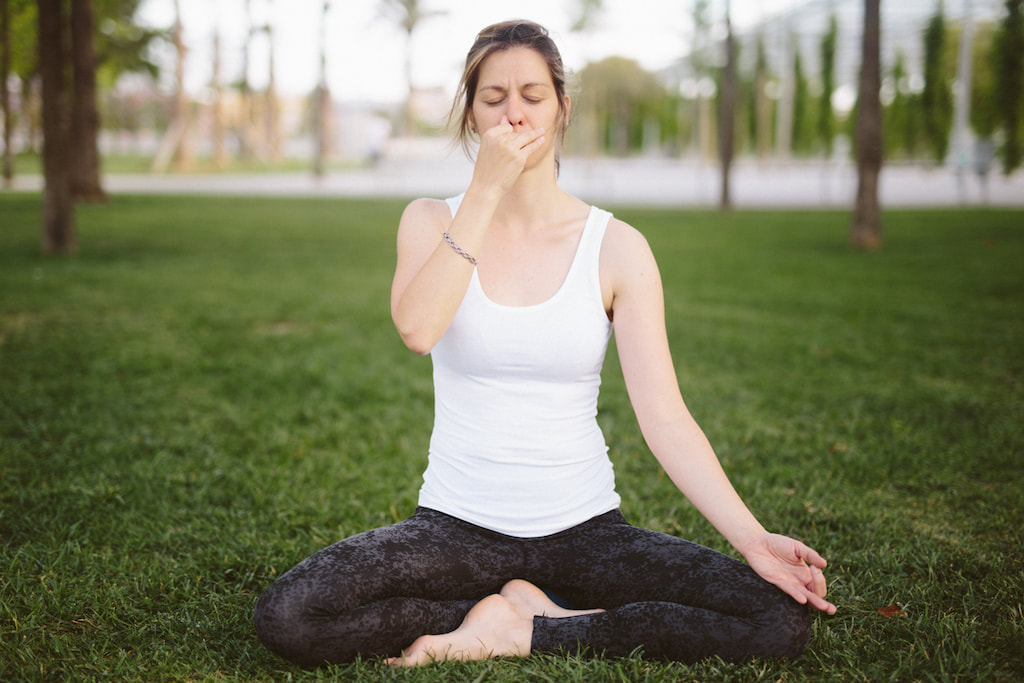|
The concept of Breathing & Pranayama has been already discussed in a separate article. This article is aimed at discussing various techniques of pranayama. Pranayama may be practised in Sukhasana, Ardha Padmasana, Pradmasana or Sidhasana. Brahmamuhurt or Amritavela (3.30 AM to 5.30 AM) is the best time for practicing Pranayama. Pranayama has different forms such as Ujjayi, Nadi Shodhana, Kapalabhati, Sitali, Bhastrika, Anulom-velom, Udgeeth etc.
Basic Ingredients:
Techniques Pranayama:
Stage – 1 - Forceful inhalation is induced by fully expanding the abdominal muscles and forceful exhalation is induced by firmly and quickly contracting the abdominal muscles only. It should be sufficiently fast so that the sniffing sound is heard in the nose as one breath in and out. The whole process of breathing should be rapid and rhythmical. After completing 10 rapid respirations, breathe in deeply through the left nostril; keep the right nostril closed, hold the breath, press the chin against the chest, contract the throat as done in jalandhara bandha, contract the perineum as in mooladhara bandha, hold the breath till comfortable, then raise head, breathe out slowly through left nostril. Stage – 2 – repeat the whole process as stage 1 through right nostril. Stage – 3 – Open both nostrils, breathe in and out deeply and rapidly 10 times through both nostrils together, then inhale deeply and slowly through both nostrils, close both nostrils, hold the breath, press the chin against the chest, contract both throat & mooladhara chakra, hold till comfortable, release the breath slowly through both nostrils.
Process – Sit in comfortable asana, hold the back upright, close the eyes, awareness at chidakasha, abdominal muscles to expand passively during inhalation, exhale with forceful contraction of abdominal muscles, repeat number of times till comfortable (60 – 100), then take one deep & slow inhalation, breathe out as much as possible, do maha bandha, end of first round, repeat rounds (3-10). People suffering from high BP, vertigo, hernia and so forth should not practice this pranayama.
Stage 2 – Synchronization of breathing with Om – continue deep breathing, mentally synchronize the mantra “Om” with the breath. O with inhalation & m with exhalation. Breathe through the nose. Continue this mantra with awareness of breath. Stage 3 – Individual chakra awareness – continue stage 2. Simultaneously fix the attention on any one of the chakras, at the eye brow centre (bhrumadhya). Feel that you are breathing in with the mental sound ‘O’ at that centre. Feel that you are breathing out with the mental sound ‘M-M-M-M’ at that centre. Continue in this manner with the awareness of breath, mantra and psychic centre. Stage 4 – Chakra piercing – fix the attention at sahsrara. With inhalation and the sound ‘O’ feel that all the chakras are being pierced in turn in the following order, starting from sahasrara-ajna-vishuddhi-anahata-manipura-swadhisthana-mooladhara. Feel the breath and ‘O’ sound moving downwards through the spine. Then with exhalation and the sound ‘M-M-M-M’ feel the chakras being pierced in turn from mooladhara upwards to Saharara. Feel the breath and ‘M’ sound moving upwards through the spine. Round one complete. Do as many rounds as possible. Stage 5 – Subtle Japa – Again chose any one chakra (eyebrow centre). Continue mental repetition of Om synchronized with the breath, but now no need to be aware of breath. Feel the ‘O’ and the ‘M’ sound at the chosen centre. Continue as long as possible. This will lead to deep introspection and relaxation of the mind. This is the end of practice. Reference: A systematic Course in the Ancient Tantric Techniques of Yoga and Kriya – by Swami Satyananda Saraswati
0 Comments
Leave a Reply. |
Archives
July 2024
Categories |

 RSS Feed
RSS Feed